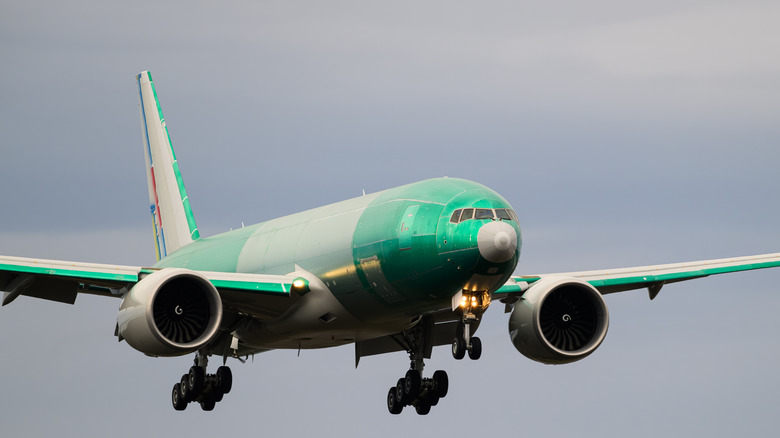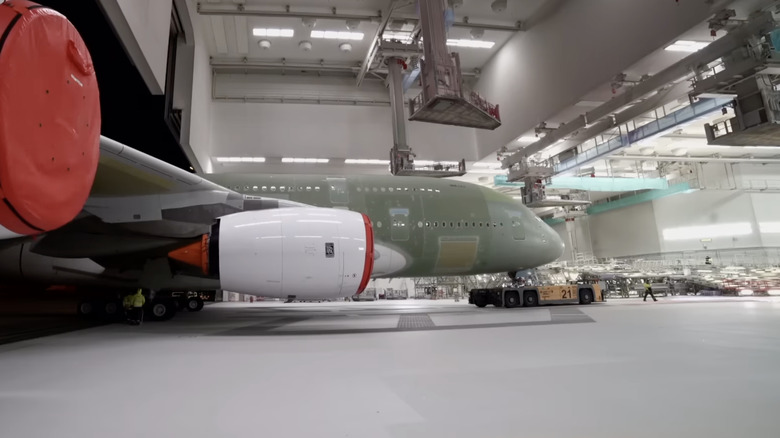Why Are New Airplanes Painted Green?
For decades, modern aircraft have been primarily made out of aluminum due to its lightweight, non-magnetic nature, and easy machineability. Stainless steel, titanium, and tungsten are also used in varied capacities, but when metal comes into contact with the elements, it suffers corrosion. Since the dawn of metallurgy, numerous techniques have been used to keep the metal from coming in contact with the chemicals in Earth's atmosphere. Coating metals with a non-reactive layer is the easiest and most well-known route, which is why you may occasionally see what appears to be a green plane.
The green paint is a protective coating made from a pigment called zinc chromate. Boeing describes zinc chromate as a "corrosion inhibiting primer designed for application to aluminum." When the metallic surface of the plane comes into contact with oxygen, it triggers a chemical reaction referred to as oxidation. The reaction damages the metal's surface and leads to corrosion; this is why planes are parked in the dry atmosphere of deserts. Layer after layer, the reaction keeps peeling away at the metal's surface, weakening it over time and reducing its structural strength.
How does a green coating protect airplanes?
Before a protective coat is applied, the metal is first treated, then a primer is applied, and finally, a top coat is put over it. The pre-treatment, also known as conversion, is done using a chromic or nitric acid mixture. When the acid is applied to the metal, it creates a chromium/aluminum complex. This material is resistant to corrosion and presents a safe surface for applying the primer layer.
The key constituent of the primer is a metallic chromate (zinc chromate, in this case), and its main role is to provide a strong adhesive layer for the top paint layer, such as the signature white on commercial carriers. More importantly, the metallic chromate inhibits corrosion. According to a detailed chemical breakdown published in the book Principles of Corrosion Engineering and Corrosion Control, chromium-based coatings are usually applied on "aluminum components, particularly on aircraft components."
According to a report released by the United States Air Force, the secret sauce for blocking corrosion is hexavalent chromium, which is commonly listed as Cr(VI). It is present in the chromic acid used for pre-treatment, and also in the metallic chromate material that is used as a primer. For the latter, the US Air Force preferred zinc chromate, but eventually switched to another chromate material that replaced zinc with another element called strontium. As per SAE International, zinc-based corrosion layers also help increase the density of the top coating and offer an inhibiting effect against metal oxidation.
The dark side of a protective green coat
Zinc chromate coating continues to be in active use in the aeronautical industry, but its health impact has been known for decades. According to a report published by the Centers for Disease Control and Prevention (US CDC), production painters were exposed to toxic concentrations of carcinogenic chromium (VI) in the form of zinc chromate. The health risk was so severe that the agency recommended that Goodyear Aerospace Corporation review and revise its environmental and medical assessment protocols and provide secure respiratory gear to the personnel.
Exposure to the constituent Chromium (VI) ion is said to have resulted in "skin ulcers, irritation and ulceration of the nasal mucosa, kidney damage, liver damage, and erosion and discoloration of the teeth" in those exposed to it through the zinc chromate coat. Another advisory issued in 1996 by the New Jersey Department of Health and Senior Services classified zinc chromate as a carcinogen, advising that it be handled with "extreme caution." The health risks cited in the report include skin, nose, and throat irritation, rash, nasal sores, and allergy, while another research paper claimed exposure could cause genetic damage.


